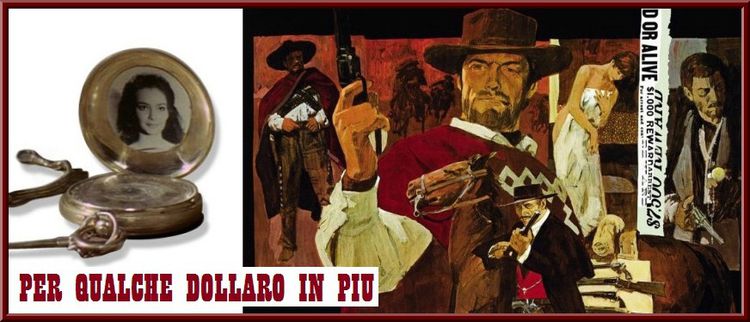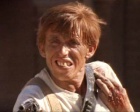For a Few Dollars More Review

For a Few dollars More (See Database Page) is the second part of Sergio Leone's Dollar trilogy. Clint Eastwood returns as a poncho-clad gunslinger, but the stranger in town from A Fistful of Dollars has become a bounty hunter and he also has a name: Monco (in Italian Manco), meaning maimed person, referring to the fact that he does everything with his left hand, except for shooting. In every part of the trilogy a new American actor was added to Leone's iconography. Eastwood's character is paired with a second bounty hunter, a former military man called Douglas Mortimer. Both men are after a pot-smoking psychopath called Indio, who was recently freed from prison by his men, and now plans to rob the bank of El Paso, a job only an idiot or a complete madman would think of. What Monco doesn't know, is that Colonel Mortimer is after El Indio for personal reasons, and is not really interested in the reward money ... In a series of flashbacks it is revealed that the colonel holds Indio responsible for the suicide of his sister ...
The second bounty hunter is played by Lee Van Cleef. Leone had seen him in High Noon and absolutely wanted to have him for the part because of his sharp features and piercing eyes. Van Cleef's Colonel Mortimer adds an emotional dimension to the movie that the first movie lacked. Being an original project (Fistful had been an adaptation of a Japanese samurai movie), his second feature gave Leone more elbow-room to experiment with shooting angles and the extreme close-ups that soon would become his trademark. The film was a smash hit, both in Italy and abroad, but it wasn't very popular among contemporary critics who thought it was overlong and too violent. Today some think it's Leone's best movie and it's often called the archetype of a spaghetti western, the one film that is all what this genre is about. The ghost towns, the dust, the heat, the gunmen, the music, the flashbacks, the hate and the vengeance, you name it, this film has it all (and a lot more). If it's not Leone's best, it may be the one with the largest amount of memorable moments. Colonel Mortimer uncovering his weaponry, the duel with the hats between the two leads, Colonel Mortimer and Monco shooting apples from a tree, El Indio having his speech about the carpenter in a church...
A special film deserves a special treat. Let's lift out some of the most notable aspects of the movie. A trip around a few dollars in a handful of steps, so to speak (1).
# The characters - Van Cleef's character is often referred to as "old man" by the younger Monco, but he owns the more sophisticated weaponry and his ways to make inquiries are more advanced than Monco's: the Colonel consults modern media such as newspapers for information about his rival, while Monco still relies on floating rumours and hearsay, brought to him by an old person significantly nicknamed 'the prophet'. The two ice-cold bounty hunters are played off by the script against their villainous antipode El Indio, a psychopath acting out of impulse or pure sadism, like in the infamous scene in which he kills the innocent wife and small child of the man who betrayed him. Even in his more lucid moments his ideas are twisted and destructive, such as the decision to set up his men against the two bounty killers.
# Time and memory - The film also marks Leone's obsession for memory and the passing of time, symbolized by the two pocket watches, whose chimes evoke the memories of the rape that led to the suicide of Colonel Mortimer's sister and the consequent feelings of hate and revenge. The pocket watch is to Colonel Mortimer what the harmonica is to Harmonica in Once Upon a Time in the West. After For a Few Dollars More nearly every revenge western would have one or more revealing flashbacks; within Leone's own body of work this Proustian way of story-telling - objects or sounds evoking memories - would finally lead to the labyrinthine narrative of Once upon a time in America, compared by Martin Scorsese to a Chinese box (2).
# The faces - It's a well-known fact that Leone partly chose his actors for their looks. He said about Lee Van Cleef that his eyes would burn holes in the screen when filmed in close-up. He especially seemed to have a good eye for villainous faces. For a Few Dollars More has probably the most impressive plethora of the ugliest and dirtiest faces in the history of the western: Klaus Kinski, Luigi Pistilli, Mario Brega, Aldo Sambrell, Benito Stefanelli, José Canelejas ... they're all there, in all their ugly wickedness, but the ugliest of them all is José Terron, the guy Colonel Mortimer shoots in Tucumcari. He is also in Django, where he plays a character called Ringo (!), and Leone would use him again, albeit for a very small part, in The good, the bad and the ugly: he is Shorty.
# The history - The remark, in the beginning of the movie about the bounty hunters, also serves as a historical marker. The film is set in the late 19th Century, when law and order in the Far West were maintained by a rather ineffective system of local sheriffs and travelling judges. Bounty hunters were not only tolerated, but often even encouraged to track down criminals that otherwise would terrorize the surroundings. The films of Leone are all but 'realistic' (think only of the super-human shooting abilities of his main characters), but he repeatedly sustained that his 'violent', 'dirty' look at the West was more correct than the cleaner vision expressed by Hollywood. To Ford the West was a desert, to be changed into a garden. To Leone the West was closer to T.S. Eliot's Waste Land.
# The autobiographical aspect - After finishing A Fistful of Dollars, Leone wanted to make a small autobiographical movie, about young people growing up in the Roman quarter of Trastevere, but he was under pressure to make a new western after the incredible success of Fistful. Some elements of his original plans have made it to For a Few Dollars More. The best example is the scene in which Eastwood and Van Cleef are shooting at each others hats, that resembles the macho-driven games of braggadocio between young men Sergio used to watch as a child from a secretive place (like the boys in the movie). According to his scriptwriter Luciano Vicenzioni, the ugly-looking, dirty, stealing, torturing villains that populate Leone's westerns have an Italian origin too: they represent the hooligans and street bullies, the footsoldiers of the more sophisticated crooks that populated the streets from Trastevere at night when Leone was young (3).
# The influence - The revenge motive, the flashback structure, the well-dressed anti-hero, his extraordinary collection of firearms ... these things would all become recurring elements within the spaghetti western genre. The teaming of the young and impetuous, and the older, more calculating gunfighter would also be picked up in some of the most interesting genre outings, notably Petroni's Death Rides a Horse, and Valerrii's Day of Anger, both starring Lee Van Cleef. It was also used by Alfio Caltabiano in Pistoleros, at the same time a homage to, and comment on Leone's masterpiece. These are all great films, but the partnership would never work as well as in For a Few Dollars More. The strange thing about all this, is that Van Cleef was only five years older than Eastwood.
# The reaction - It's no wonder that a film this influential would provoke some kind of reaction. In the above mentioned Pistoleros, writer/director Caltabiano clearly shows that bounty hunting was a dirty job and that it was difficult for those practicing it, to keep their hands clean. Franco Giraldi's ambitious A Minute to Pray, a Second to Die is also a bitter comment on Leone's all too gentle approach of the professional bounty killer. But the most incisive comment was given by Leone's friend and rival Corbucci, the other Sergio, in his icy nightmare The Great Silence.

Director: Sergio Leone - Cast: Clint Eastwood, Lee van Cleef, Gian Maria Volonté, Klaus Kinski, Luigi Pistilli, Mario Brega, Aldo Sanbrell, Mara Krup, Josef Eggar, Kurt Zipps, Benito Stefanelli, Ricardo Palacios, Dante Maggio, Rosemary Dexter, Peter Lee Lawrence, José Terron - Music: Ennio Morricone
Notes:
- (1) I owe the idea to a French blogger called tepepa, see : http://tepepa.blogspot.com/2007/06/les-petites-choses-dans-et-pour.html
- (2) A Conversation with Martin Scorsese about Sergio Leone, in: Christopher Frayling, Once upon a time in Italy
- (3) Marco Giusti, Dizionario Del Western All'Italiana
--By Scherpschutter




